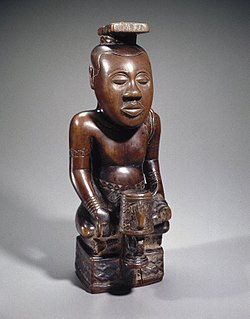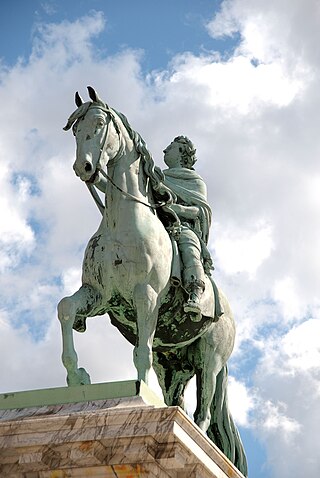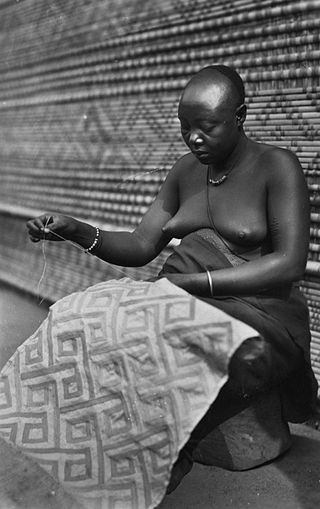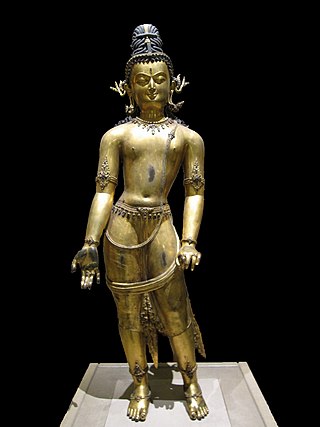
Ndop were figurative sculptures representing different kings (nyim) of the Kuba kingdom.

Ndop were figurative sculptures representing different kings (nyim) of the Kuba kingdom.
Although the sculptural genre appears naturalistic, ndop are not actual one-to-one representations of particular subjects, but rather a culmination of visual notations that represented the ideal characteristics of the deceased king. The reign of individual rulers are identified by a small emblem, called an ibol, at the base of the sculpture. Each ibol is rendered with a great degree of customization and personalization in an otherwise formal and naturalistic standardization. [1] Measuring about 48-55 centimeters in height, ndop were carved in hardwood and anointed with palm oil to protect them from insects, which is unique in African art and underscores their survival in Western collections today. Ndop sculptures depict subjects sitting cross-legged, a posture that is equally unique in African sculpture.
Ndop frequently portray the ruler carrying a weapon in his left hand, an ikul or peace knife, made in the style reserved for the Bushoong, the dominant sub-group of the Kuba. The wooden portraits were kept in the king's quarters with other sculptures referred to as 'royal charms', upon which the king's magical powers rested. When the king was absent from the capital, the ndop were rubbed with oil. Scholars agree that the tradition of the king's "portrait statue" was begun in the late eighteenth century. [2] [3]

To create the distinct round contours of this sculpture, the sculptor primarily worked with an adze, which has a wooden handle to which a metal blade is attached at an acute angle. Knives and a burnisher were also used. Kuba carvers demonstrated fine hand and eye coordination to bring out details with the combination of these tools. In addition to the naturalistic shape of the facial features and body parts, the sculptor reproduces realistic detail on the body, including the collarbones and outline of the lips. [1]

The durable hardwood and the palm oil anointments underscore the longevity of these works, the earliest examples of which, such as the ndop in the Brooklyn Museum’s collection, are among the oldest surviving wood works from the continent. Three wooden ndop figures from the Kuba kingdom currently reside in the British Museum. Collected by the Hungarian explorer Emil Torday, one of them is estimated to date back to the eighteenth century, making it one of the oldest wooden sculptures extant from Sub-Saharan Africa. [4] Two similar figures are in the Royal Museum for Central Africa in Belgium. [5] [6]
After the rites of investiture were completed, it is said that the nyim commissioned a sculptor to sculpt his likeness in the form of the ndop. Only one ndop could be made for a king, and if he was not present it could not be sculpted. If the figure decayed over time, it was permissible to sculpt an exact replica.
As a site of the king's life force after death, it was believed that the ndop supposedly housed the nyim's double, the counterpart of his soul. It was believed that if anything happened to the king, it would be reflected in the ndop. For example, if a king were to be wounded in battle, a similar wound would appear on the ndop sculpture. [7] The statue was kept in the women's quarters, and when a woman of the harem was about to give birth, it was placed near her to insure a safe delivery. In the absence of the king it served as a surrogate, which women of the court would anoint and stroke. After his death, the ndop was removed to a storage room and taken out to be exhibited only on certain occasions. [7]

Sculpture is the branch of the visual arts that operates in three dimensions. Sculpture is the three-dimensional art work which is physically presented in the dimensions of height, width and depth. It is one of the plastic arts. Durable sculptural processes originally used carving and modelling, in stone, metal, ceramics, wood and other materials but, since Modernism, there has been almost complete freedom of materials and process. A wide variety of materials may be worked by removal such as carving, assembled by welding or modelling, or moulded or cast.

Joseph Nollekens R.A. was a sculptor from London generally considered to be the finest British sculptor of the late 18th century.

African art describes the modern and historical paintings, sculptures, installations, and other visual culture from native or indigenous Africans and the African continent. The definition may also include the art of the African diasporas, such as: African-American, Caribbean or art in South American societies inspired by African traditions. Despite this diversity, there are unifying artistic themes present when considering the totality of the visual culture from the continent of Africa.

The sculpture of ancient Greece is the main surviving type of fine ancient Greek art as, with the exception of painted ancient Greek pottery, almost no ancient Greek painting survives. Modern scholarship identifies three major stages in monumental sculpture in bronze and stone: the Archaic, Classical (480–323) and Hellenistic. At all periods there were great numbers of Greek terracotta figurines and small sculptures in metal and other materials.

The Kuba Kingdom, also known as the Kingdom of the Bakuba or Bushongo, is a traditional kingdom in Central Africa. The Kuba Kingdom flourished between the 17th and 19th centuries in the region bordered by the Sankuru, Lulua, and Kasai rivers in the heart of the modern-day Democratic Republic of the Congo.

Sir William Goscombe John was a prolific Welsh sculptor known for his many public memorials. As a sculptor, John developed a distinctive style of his own while respecting classical traditions and forms of sculpture. He gained national attention with statues of eminent Victorians in London and Cardiff and subsequently, after both the Second Boer War and World War I, created a large number of war memorials. These included the two large group works, The Response 1914 in Newcastle upon Tyne and the Port Sunlight War Memorial which are considered the finest sculptural ensembles on any British monument.

Most African sculpture was historically in wood and other organic materials that have not survived from earlier than at most a few centuries ago; older pottery figures are found from a number of areas. Masks are important elements in the art of many peoples, along with human figures, often highly stylized. There is a vast variety of styles, often varying within the same context of origin depending on the use of the object, but wide regional trends are apparent; sculpture is most common among "groups of settled cultivators in the areas drained by the Niger and Congo rivers" in West Africa. Direct images of African deities are relatively infrequent, but masks in particular are or were often made for traditional African religious ceremonies; today many are made for tourists as "airport art". African masks were an influence on European Modernist art, which was inspired by their lack of concern for naturalistic depiction.

Luisa Ignacia Roldán, known also as La Roldana, was a Spanish sculptor of the Baroque Era. She is the earliest woman sculptor documented in Spain. Roldán is recognized in the Hispanic Society Museum for being "one of the few women artists to have maintained a studio outside the convents in Golden Age Spain".

Nottingham alabaster is a term used to refer to the English sculpture industry, mostly of relatively small religious carvings, which flourished from the fourteenth century until the early sixteenth century. Alabaster carvers were at work in London, York and Burton-on-Trent, and many probably worked very close to the rural mines, but the largest concentration was around Nottingham. This has led to all the English medieval output being referred to as "Nottingham alabaster".
Dana King is an American broadcast journalist and sculptor. She served as an anchor for the CBS owned-and-operated station KPIX-TV in San Francisco. In 2012, King left KPIX to pursue her passion in sculpting and art. Her outdoor sculpture commemorating the Montgomery bus boycott is displayed at the National Memorial for Peace and Justice in Montgomery, Alabama. King uses historically generalized and racist ideas that requires indepth researches, to provide information on the normative misrepresentation of Black peoples' emotional and physical sacrifices.

Zenos Frudakis, known as Frudakis, is an American sculptor whose diverse body of work includes monuments, memorials, portrait busts and statues of living and historic individuals, military subjects, sports figures and animal sculpture. Over the past four decades he has sculpted monumental works and over 100 figurative sculptures included within public and private collections throughout the United States and internationally. Frudakis currently lives and works near Philadelphia, and is best known for his sculpture Freedom, which shows a series of figures breaking free from a wall and is installed in downtown Philadelphia. Other notable works are at Arlington National Cemetery in Virginia, Brookgreen Gardens in South Carolina, the National Academy of Design, and the Lotos Club of New York City, the Imperial War Museum in England, the Utsukushi ga-hara Open Air Museum in Japan, and the U.S. Embassy in Pretoria, South Africa.
Alfred Turner was an English sculptor notable for several large public monuments. These included statues of Queen Victoria, works in the Fishmonger's Hall in London and several war memorials, both in the Britiah Isles and abroad.

Danish sculpture as a nationally recognized art form can be traced back to 1752 when Jacques Saly was commissioned to execute a statue of King Frederick V of Denmark on horseback. While Bertel Thorvaldsen was undoubtedly the country's most prominent contributor, many other players have produced fine work, especially in the areas of Neoclassicism, Realism, and in Historicism, the latter resulting from growing consciousness of a national identity. More recently, Danish sculpture has been inspired by European trends, especially those from Paris, including Surrealism and Modernism.

Kuba art comprises a diverse array of media, much of which was created for the courts of chiefs and kings of the Kuba Kingdom. Such work often featured decorations, incorporating cowrie shells and animal skins as symbols of wealth, prestige and power. Masks are also important to the Kuba. They are used both in the rituals of the court and in the initiation of boys into adulthood, as well as at funerals. The Kuba produce embroidered raffia textiles which in the past was made for adornment, woven currency, or as tributary goods for funerals and other seminal occasions. The wealth and power of the court system allowed the Kuba to develop a class of professional artisans who worked primarily for the courts but also produced objects of high quality for other individuals of high status.

Kuba textiles are a type of raffia cloth unique to the Democratic Republic of the Congo, formerly Zaire, and noted for their elaboration and complexity of design and surface decoration. Most textiles are a variation on rectangular or square pieces of woven palm leaf fiber enhanced by geometric designs executed in linear embroidery and other stitches, which are cut to form pile surfaces resembling velvet. Traditionally, men weave the raffia cloth, and women are responsible for transforming it into various forms of textiles, including ceremonial skirts, ‘velvet’ tribute cloths, headdresses and basketry.

The Bushong Kuba are responsible for some of the most beautiful and sophisticated masquerade or dance traditions in Africa.

The Bronze Head from Ife, or Ife Head, is one of eighteen copper alloy sculptures that were unearthed in 1938 at Ife in Nigeria, the religious and former royal centre of the Yoruba people. It is believed to represent a king. It was probably made in the fourteenth-fifteenth century C.E. The realism and sophisticated craftsmanship of the objects challenged the offensive and patronising Western conceptions of African art. The naturalistic features of the Ife heads are unique and the stylistic similarities of these works "suggest that they were made by an individual artist or in a single workshop."

Emil Torday, was a Hungarian anthropologist. He was the father of the romance novelist Ursula Torday.

The sculpture of Nepal is best known for small religious figures and ritual objects in bronze or copper alloy, but also has other strengths. The Newar people of Nepal had a long-lasting specialism in casting small bronze figures, mostly religious and especially Buddhist, considerable numbers of which were exported to India and Tibet over many centuries.
Dora Thacher Clarke, later Dora Middleton, (1895–1989) was a British sculptor and wood carver who also wrote about, and promoted African art.
{{cite book}}: CS1 maint: location missing publisher (link)